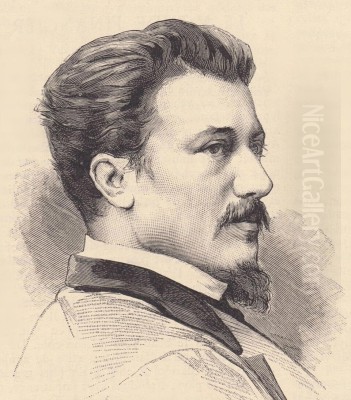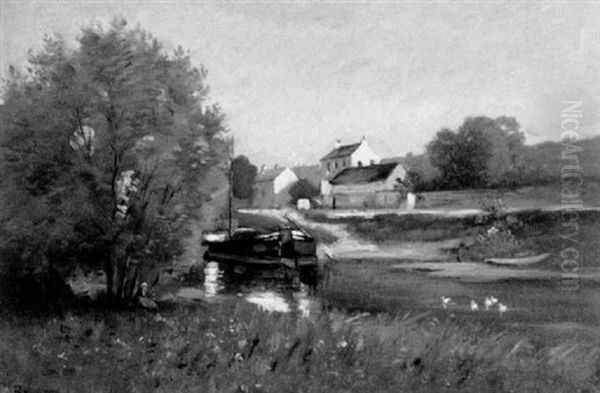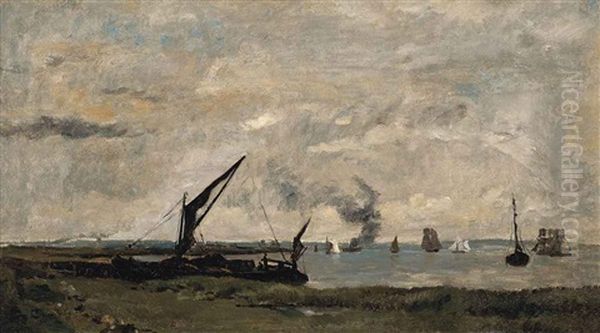Introduction: A Legacy Inherited

Karl Pierre Daubigny entered the world on June 9, 1846, in Paris, born into a lineage already deeply etched into the annals of French art history. He was the son of Charles-François Daubigny, a towering figure in 19th-century landscape painting, a key member of the Barbizon School, and a recognized precursor to Impressionism. From his earliest days, Karl Pierre was immersed in an environment where art was not just a profession but a way of life, surrounded by the sights, sounds, and discussions of a revolutionary period in painting. His own life, tragically cut short in 1886 at the age of forty, unfolded under the considerable shadow and influence of his father, presenting both unique opportunities and inherent challenges as he sought to carve out his own artistic identity.
Karl Pierre Daubigny dedicated his career to landscape painting, following closely in his father's thematic footsteps. He developed a sensitivity to the nuances of nature, focusing his brush on the specific atmospheres and terrains of regions like Normandy and the environs of the Fontainebleau forest. While inevitably linked to his father's style and the Barbizon ethos, his work also absorbed the vibrations of the burgeoning Impressionist movement, reflecting a generational bridge between established realism and radical new ways of seeing and depicting the natural world. This exploration aims to illuminate the life and work of Karl Pierre Daubigny, acknowledging his heritage while appreciating his individual contributions to French landscape painting.
Early Life and Artistic Formation
Growing up in the Daubigny household meant constant exposure to the practice and discourse of art. Charles-François Daubigny was not only a successful painter but also an innovator, known for his dedication to painting outdoors (en plein air) and even constructing a studio boat, "Le Botin," to capture waterside scenes directly from nature. This environment undoubtedly provided Karl Pierre with an unparalleled, albeit informal, art education from infancy. His father's studio, his travels, and the artists who frequented their circle formed the backdrop of his youth.

It is almost certain that Karl Pierre received his primary artistic training directly from his father. Charles-François's approach, which evolved from a more detailed style towards a looser, more atmospheric rendering emphasizing light and mood, would have been the foundational technique imparted to his son. The Barbizon School's core tenets – direct observation of nature, rejection of academic historical landscapes, and a focus on humble, rural scenery – were the principles Karl Pierre inherited. He learned to sketch outdoors, to observe the changing effects of light and weather, and to translate these observations into paint.
The family's connection to places like Barbizon, Auvers-sur-Oise, and the Normandy coast meant that Karl Pierre's early visual vocabulary was shaped by the very landscapes that had inspired his father and his contemporaries. He learned to see the beauty in the tranquil rivers, the dense forests, and the dramatic coastlines that were central to the Barbizon and early Impressionist movements. This upbringing provided him with technical skills and a deep-seated appreciation for the French landscape, setting the stage for his own artistic endeavors.
Emergence at the Paris Salon
The Paris Salon, the official art exhibition sponsored by the French state and overseen by the Académie des Beaux-Arts, was the primary venue for artists to gain recognition, attract patrons, and establish their careers in the 19th century. Acceptance into the Salon was a crucial step for any aspiring painter. For Karl Pierre Daubigny, debuting at this prestigious exhibition marked his formal entry into the professional art world.
Remarkably, Karl Pierre made his first appearance at the Salon at the young age of eighteen, in 1864. This early acceptance was a significant achievement, indicating a level of technical proficiency and artistic promise recognized by the jury. It also signaled his intention to follow a professional path similar to his father's, engaging with the established art system even as new, independent exhibition venues were beginning to emerge with the Impressionists.
His early success continued. By the age of twenty-two, around 1868, Karl Pierre had already garnered awards at the Salon. Winning medals or honorable mentions at the Salon brought increased visibility and critical attention. For the son of Charles-François Daubigny, such accolades were important in demonstrating his own merit and distinguishing his work, to some extent, from his father's already established reputation. These early triumphs suggested a promising trajectory for the young artist within the competitive Parisian art scene.
Artistic Style: Between Barbizon and Impressionism

Karl Pierre Daubigny's artistic output centered firmly on landscape painting. He developed a particular affinity for the scenery of Normandy, with its varied coastline and pastoral inland areas, and the Forest of Fontainebleau, the spiritual home of the Barbizon School. His works often depict tranquil rural settings, riverbanks, coastal views, and woodland interiors, rendered with a sensitivity to natural light and atmosphere.
His style reflects a confluence of influences. The foundation laid by his father, Charles-François, is evident in the commitment to direct observation and the realistic depiction of specific locales. The Barbizon preference for naturalism and the poetic rendering of the French countryside permeates his work. However, Karl Pierre painted during a period when Impressionism was revolutionizing the art world, and he was not immune to its effects.
Sources note that his style was influenced by Impressionism, and specifically by Claude Monet, a close associate of his father. This influence might be seen in a brighter palette compared to some earlier Barbizon works, a looser brushstroke intended to capture fleeting effects of light, and an overall emphasis on the sensory experience of being in nature. Yet, Karl Pierre is generally not considered a core member of the Impressionist group. His work often retained a greater sense of structure and solidity, perhaps a lingering attachment to the Barbizon aesthetic, compared to the more radical dissolution of form found in the works of Monet or Pissarro during the 1870s. He navigated a path that acknowledged Impressionist innovations without fully abandoning his Barbizon roots.
The Daubigny Legacy: Father and Son
To understand Karl Pierre Daubigny, one must consider the immense artistic presence of his father, Charles-François Daubigny (1817-1878). The elder Daubigny was not merely a successful painter; he was a pivotal figure who bridged the gap between the Barbizon School and Impressionism. His dedication to en plein air painting, particularly from his studio boat "Le Botin" on the Oise River, was revolutionary. He captured the fluidity of water and the transient effects of light with unprecedented immediacy, earning praise from critics like Théophile Gautier but also facing criticism for his "sketchy" finishes.
Charles-François was a central figure in the Barbizon group, working alongside artists like Jean-Baptiste-Camille Corot, Jean-François Millet, and Théodore Rousseau. His style evolved under the influence of painters like Corot, known for his silvery light, and Gustave Courbet, the champion of Realism. Charles-François moved towards a freer application of paint and a greater emphasis on capturing atmospheric conditions, qualities that deeply resonated with the younger generation.
His importance as a precursor to Impressionism cannot be overstated. He championed the works of younger artists, including Claude Monet and Camille Pissarro, reportedly using his influence as a Salon jury member to support their submissions. During the Franco-Prussian War, while in London in 1871, Charles-François encountered Monet and introduced him to the art dealer Paul Durand-Ruel, who would become the Impressionists' most crucial supporter. He also knew Paul Cézanne during his time in Auvers-sur-Oise. His own later works, with their broken brushwork and focus on light, clearly anticipate Impressionist techniques. Vincent van Gogh deeply admired him, later painting Daubigny's Garden in Auvers as a tribute.
Karl Pierre grew up and worked within this context. His father's fame provided access and connections but also created a standard against which his own work would inevitably be measured. While he adopted many of his father's subjects and techniques, Karl Pierre sought his own voice, subtly incorporating newer trends while remaining faithful to the landscape tradition he inherited. His relationship with his father's legacy was likely complex – a source of both inspiration and pressure.
Themes and Representative Works
Karl Pierre Daubigny's oeuvre, though less extensive than his father's due to his shorter life, focused intently on the French landscape. His choice of subjects often mirrored his father's interests but also showed personal preferences. He frequently painted the banks of the Oise River, a location immortalized by his father, capturing the calm waters, reflective surfaces, and lush vegetation of the region. Works titled Banks of the Oise exemplify this recurring theme.
He was also drawn to the coastal scenery of Normandy. Villages like Villerville appear in his paintings, showcasing his ability to depict the interaction of land, sea, and sky. These coastal scenes, perhaps influenced by contemporaries like Eugène Boudin (Monet's early mentor) known for their Normandy beach scenes, allowed him to explore different light conditions and atmospheric effects compared to the inland river valleys. Titles such as Sunset on the Coast suggest an interest in capturing the dramatic, transient moments of the day, a concern shared with the Impressionists.
The Forest of Fontainebleau, the cradle of the Barbizon School, was another significant location for Karl Pierre. He painted woodland interiors and clearings, continuing the Barbizon tradition of finding poetic beauty in the unadorned natural world. While specific titles might be less famous than his father's major works like Spring or The Barges (both in the Louvre), Karl Pierre's paintings consistently demonstrate a high level of skill and a genuine connection to the landscapes he portrayed. His works are characterized by competent compositions, a sensitive handling of light, and often a tranquil, contemplative mood.
Interactions and the Artistic Milieu
While specific records of Karl Pierre Daubigny's interactions with other artists are less documented than those of his famous father, his position within the Parisian art world ensured he was part of a vibrant community. Growing up, he would have known the prominent Barbizon figures who were his father's colleagues – Corot, Millet, Rousseau, Jules Dupré, Constant Troyon. These artists represented the established generation of landscape painters focused on naturalism.
As he matured, Karl Pierre operated during the rise of Impressionism. His father's known support for and friendship with key Impressionists like Monet and Pissarro likely meant Karl Pierre had direct or indirect contact with this younger, more radical group. The mention of Monet's influence on his style suggests an awareness and engagement with Impressionist ideas, even if he didn't fully adopt their methods or participate in their independent exhibitions.
He would have encountered artists like Alfred Sisley, another landscape painter deeply influenced by Charles-François Daubigny and focused on river scenes and light effects. The artistic debates of the time – the merits of the Salon versus independent shows, the value of a "finished" painting versus a sketch-like impression, the importance of capturing modern life – would have been familiar territory. Karl Pierre's career unfolded amidst these dynamic shifts, positioning him as an artist connected to both the legacy of Barbizon realism and the innovations of Impressionism. His association with Paul Durand-Ruel, facilitated by his father, might also have brought him into contact with other artists represented by the gallery.
Place in Art History: A Promising Career Cut Short
Karl Pierre Daubigny occupies a specific place in late 19th-century French art history, primarily recognized as a talented landscape painter working in the tradition of his father but touched by the emerging Impressionist aesthetic. He is often seen as a transitional figure, embodying the continuation of the Barbizon spirit into a new artistic era. His work demonstrates the enduring appeal of naturalistic landscape painting while subtly incorporating newer approaches to light and brushwork.
Compared to his father, Charles-François, or the leading Impressionists like Monet, Renoir, Degas, or Pissarro, Karl Pierre's name is less prominent. This is partly due to his tragically early death in 1886 at the age of forty. A career spanning less than two decades naturally limited his output and the potential for further stylistic evolution. Had he lived longer, it is possible his work might have developed in new directions, perhaps more fully embracing Impressionism or forging a more distinct path.
His legacy lies in his competent and often beautiful depictions of the French countryside, particularly Normandy and the Oise valley. His paintings serve as a testament to the enduring strength of the Barbizon tradition of direct observation and poetic naturalism. They also reflect the pervasive influence of Impressionism on artists of his generation, showcasing how even those not fully part of the movement absorbed elements of its revolutionary approach to capturing light and atmosphere. He remains an important figure for understanding the nuances of the artistic landscape in France during the 1860s, 70s, and 80s, representing a generation that navigated the powerful currents of established tradition and radical innovation.
Conclusion: An Enduring Contribution
Karl Pierre Daubigny's life (1846-1886) was one of artistic dedication lived under the significant influence of his father, Charles-François Daubigny. Born into the heart of the Barbizon movement and maturing during the ascent of Impressionism, his work reflects both these powerful forces. He established himself as a capable and sensitive landscape painter in his own right, achieving early recognition at the Paris Salon and developing a focus on the specific terrains of Normandy and the Fontainebleau region.
While inheriting the Barbizon commitment to naturalism and en plein air study, Karl Pierre's style also showed an awareness of Impressionist techniques, particularly in the handling of light and atmosphere, likely influenced by artists like Monet whom his father championed. He produced a body of work characterized by tranquil scenes, careful observation, and a gentle, poetic sensibility. Representative works depicting the banks of the Oise, coastal views at Villerville, and forest scenes capture the essence of the French landscape that so inspired his family.
Though his career was cut short by his premature death, Karl Pierre Daubigny made a tangible contribution to French landscape painting. He stands as an example of an artist navigating the complex artistic currents of the late nineteenth century, bridging the legacy of the Barbizon school with the innovations that were reshaping visual representation. His work offers a valuable perspective on this transitional period and endures as a testament to his talent and his deep connection to the natural world. He remains a figure worthy of study, an artist who, while perhaps overshadowed by his father's fame, carved out his own space within the rich tapestry of French art.